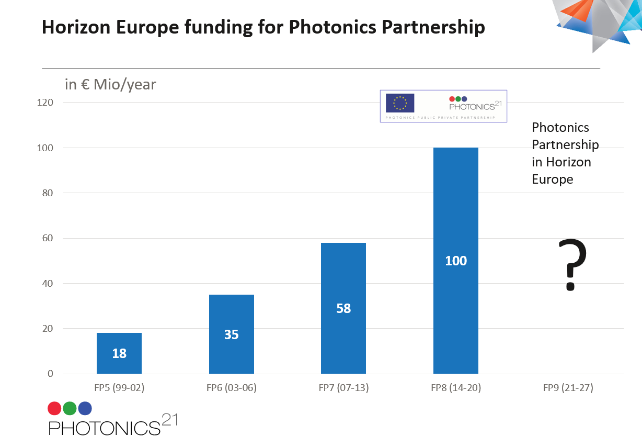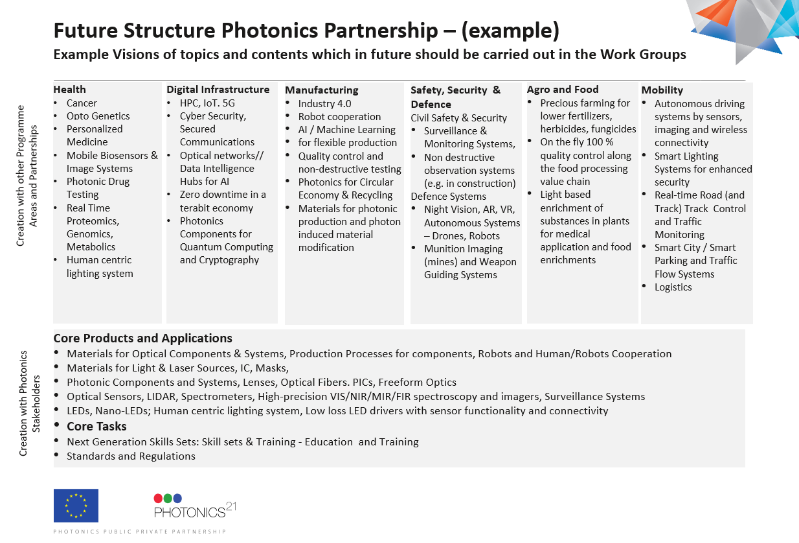Despite photonics funding having grown significantly in past European Commission framework programmes, it is ‘highly unlikely’ to happen again in the ninth framework programme, Horizon Europe, attendees of the Photonics West Digital Forum were told.
Photonics21, the European photonics public-private partnership, expects photonics funding to decrease in Horizon Europe (2021-2027).
There will, however, still be many opportunities to access additional funding through co-operating more closely with end-user sectors, according to Photonics21 head of operations Markus Wilkens, who spoke at an industry event at the forum in March.
‘This time there are only 50 partnerships, which means a lot of budget is more free floating in application areas,’ he explained. ‘By partnering with these we could gain additional budget for photonics in order to drive the area, and this is in line with the overall strategy of Photonics21 for the next framework programme – to get much closer to the application areas through joint calls and initiatives.’
Partnerships are an instrument implemented in the last framework programme, Horizon 2020 (2014-2020). They are public-private partnerships, in which private partners and the European Commission collaborate to invest in a joint research and innovation strategy.
In Horizon Europe, the number of partnerships has been reduced to 50 from 100 in Horizon 2020. But thanks to the joint effort of European Photonics organisations at all levels, in addition to Nobel Laureates, who together advocated the importance and impact of photonics to national governments and the Commission, photonics has once again remained as a partnership.
This is very significant for the recognition of photonics as a strategic field, and the allocation of budget within the new programme. Photonics was also recognised as a key enabling technology by the European Commission in its new industrial strategy, plus a key technology in fighting the pandemic in its Coronavirus strategy.
The European Partnership for Photonics is one of 10 within the ‘Digital, Industry and Space’ cluster of Horizon Europe’s Pillar 2: Global Challenges and European Industrial Competitiveness. Five other clusters are part of this pillar, one of three pillars making up the framework programme.
The cluster has access to €15.5bn of the €53.8bn budget allocated to Pillar 2 over the course of the programme. According to Wilkens, it is only towards the end of Horizon Europe that we will be able to see how much of the budget has been spent on photonics. The budget of previous programmes can be seen in figure one, with Horizon 2020 having allocated approximately €100m to photonics.

Figure one: Under Horizon 2020 (2014-2020) photonics recieved approximately €100m of funding. The photonics budget for Horzon Europe (2021-2027) is not yet known
As outlined by Wilkens, working more closely with end-user sectors to gain additional budget for photonics will be one of the focus areas of the new European Partnership for Photonics in Horizon Europe.
The core work group of the partnership will focus on strengthening outreach to application areas, as well as further developing core photonics technologies.
‘We want to have joint strategies with several application areas, we want to work together with them, have more shows and joint initiatives, not only at the European level but also at the regional level,’ he explained. ‘We’ll come up with proposals for joint calls between photonics and these areas, and also seek to strengthen co-operation over the short-term.’
Examples given by Wilkens of the end-use areas that photonics can work closely with and make a difference in, are shown in figure two.

Figure two: Examples of the end-use sectors where photonics can make a difference
New political aims and startup support
Horizon Europe is responding particularly to discussions that have been going on in Europe for quite a while, according to Wilkens.
‘Some political aims and targets have been defined,’ he said. ‘Some of the main driving forces for Horizon Europe are: the Green Deal [making Europe climate neutral by 2050], digitisation and technology sovereignty.
‘There is also a new element on EU-wide R&I missions (or ‘man to the moon’ initiatives if you wish), with some that have already been agreed: the fight against cancer, green transport and plastic-free oceans.’
In addition, a new instrument in the framework programme is the European Innovation Council, which aims to bring promising ideas from the lab to real-world applications, in addition to supporting startups and companies in scaling up their ideas, through innovative ways of financing.
This will address a particular weakness of Europe, according to Wilkens: ‘Very often we have good companies and startups, but scaling is an issue, many companies have not managed to scale up like in other areas of the world.’
Photonics21 is currently working with the European Commission on defining the KPIs of the new European Partnership for Photonics for Horizon Europe, as well as how to monitor the KPIs. This will be finalised by April/May, which is also when the first calls of the European Partnership for Photonics will be published under the industrial leadership and photonics area of the Horizon Europe Work programme 2021/22. The call deadline will be either late August or early September.


